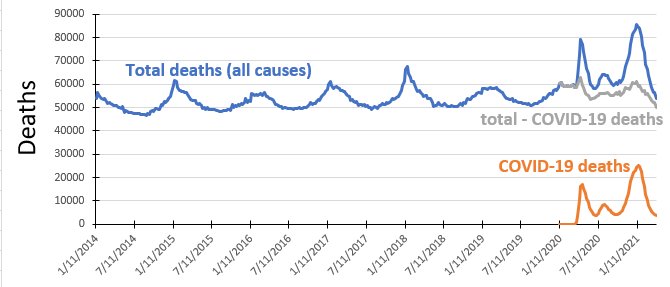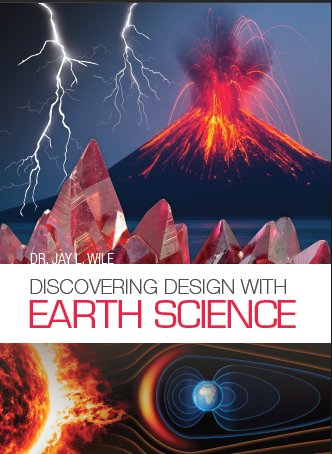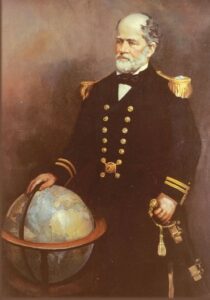
Over the past few weeks, I have gotten some emails regarding COVID-19 that were filled with misinformation. In an attempt to clear up this misinformation, I thought I would look at some data that are rather easy to obtain and analyze: total deaths in the U.S. over the past seven years and the deaths attributed to COVID-19. They come from the CDC, which I know many of my readers don’t trust. Indeed, I don’t trust the CDC when it comes to many of their recommendations, including some related to COVID-19. Nevertheless, these data are rather hard to manipulate, since they come from many independent sources. Thus, while they might not be 100% accurate, the overall conclusions we can draw from them should be reliable.
Looking at the above graph, then, what do we see? Let’s start with the total deaths (in blue). They follow a familiar pattern in the five years leading up to 2020. They peak in January, trail off in the summer, and start rising again in autumn. The peaks are generally attributed to two things: cold weather is more deadly than warm weather, and the influenza season typically peaks in January/February. Indeed, if you look at the heights of the peaks in the years before 2020, you can see when the more severe influenza seasons were: 2015 and 2018.
Notice, however, that 2020 and 2021 break the pattern established in the previous years. The peak in 2020 is much, much higher than the peaks in the previous years, and it comes later in the year (mid-April). In addition, when it comes back down to its minimum (late June), it is much, much higher than the minimum of any other year. Then, there is a bump that occurs later in the year, followed by another peak that is even higher than the one in April of 2020. Clearly, this tells us something unusual happened in 2020, and it is still happening in 2021.
Of course, we know what that unusual situation is: COVID-19. If we graph just the deaths attributed to COVID-19 (in orange), you see the same unusual pattern: a peak that occurs in April of 2020, another bump, and then an even larger peak. Just to see how much of this unusual pattern can be attributed to the COVID-19 deaths, the gray line shows you what happens when you take the total deaths and subtract the COVID-19 deaths. The result is something that looks a lot more like the pattern that was established in the past seven years. However, the pattern isn’t exactly the same as what is seen in the previous years. Notice that the gray line never gets as low as the blue line does in 2014-2019. Thus, even after subtracting out the COVID-19 deaths, there are still more deaths than in the previous years.
What does all this mean? Well, let’s start with two things we can say for certain. First, contrary to what you may have heard (and what I was sent in email), COVID-19 is NOT just a severe flu-like disease. It is responsible for more deaths than any flu in the past seven years. Indeed, the only influenza that was more deadly than COVID-19 in the U.S. (as of right now, anyway) was the 1918 Spanish flu. Second, COVID-19 deaths are not being significantly over-reported. If that were the case, subtracting out the COVID-19 deaths would have resulted in fewer deaths than in previous years (the gray line would have dipped lower than the blue line dips in previous years).
What can we say about the fact that even after subtracting out the COVID-19 deaths, there are still more deaths in 2020 and 2021 than the previous years? As I see it, there are two possibilities. It’s possible that COVID-19 deaths are being under-reported. It’s also possible that the COVID-19 measures that have been instituted have produced some deaths as well. I think the second option is more likely. Social isolation, delaying doctor appointments, etc., will result in more deaths. However, the number of those deaths is small compared to the COVID-19 deaths.
There is one more thing that I see in the data, but it is preliminary at best. Notice that the peak occurred much sooner this year than last. While the peak number of deaths in 2020 occurred in April, this year’s peak occurred in January. Assuming the virus hasn’t changed substantially over the past year, that means something happened to curtail COVID-19 deaths. What happened between 2020 and 2021? The vaccine started rolling out. The first doses were given in December of 2020, and the initial focus was on health care providers and those who are most at risk of dying from COVID-19. To me, it isn’t surprising that this produced enough of a slowdown in COVID-19 to cut the peak back three months. Once again, that is a preliminary conclusion which could be wrong. However, I do think that time will bear it out to be true. Regardless, I will post a similar analysis in a few months to see what the data say then.

 My latest book has been sent to the printer, and it should be ready in June. To learn more about it,
My latest book has been sent to the printer, and it should be ready in June. To learn more about it, 